Writing Memorable Settings: Turning Space into Place, Act 3
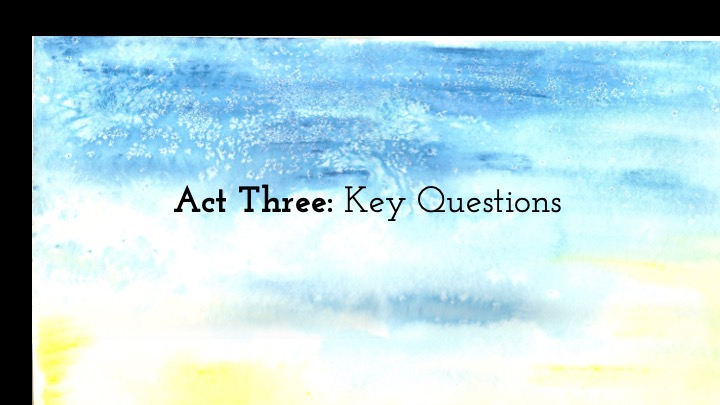
When I talked to Cynthia Voigt about the ideas of place attachment and our psychological connection to place, she said she uses maps to orient herself within a story because she doesn’t like to feel “geographically dislocated” as she writes.
When we discussed A Solitary Blue she said, “I think of Solitary Blue as a setting book in the sanctuary aspect of the Chesapeake Bay for Jeff.”
That’s it in a nutshell. She knows the heart of Jeff’s story, and every aspect of the settings relate to Jeff’s abandonment … and his search for a sanctuary.
I think we really feel this book because Voigt’s setting and Jeff’s emotional journey are always in tight parallel. The same is true with Dicey.
You may not think about your own story’s setting first, but you probably have a sense of where your story must take place.
You have instincts about setting – all you have to do is follow them with these key techniques we’re going to practice:
Identify the physical features of the setting.
Identify the emotional features of the setting.
Then, explore how both aspects change over the course of the story.
You can do this during drafting or revision but having a destination when you start out – like Jeff’s sanctuary – can keep you pointed in the right direction.
I’m going to walk you through some prompts and I’ve provided several examples at the end– including picture books and young adult so you can see how the technique applies across genres.
Think about the beginning of your story.
Focus on your main character. If you don’t have a current work in progress, you can do this exercise based on your own experience and think of yourself as the character.
Choose one significant setting from the beginning.
It can be positive or negative.
Maybe a room, home, school, or a natural environment.
If you’re using yourself as the character, you may want to think of a place you loved of or a place that scared you.
Now, describe the physical setting in the first box and the emotional features of the setting in the second box.
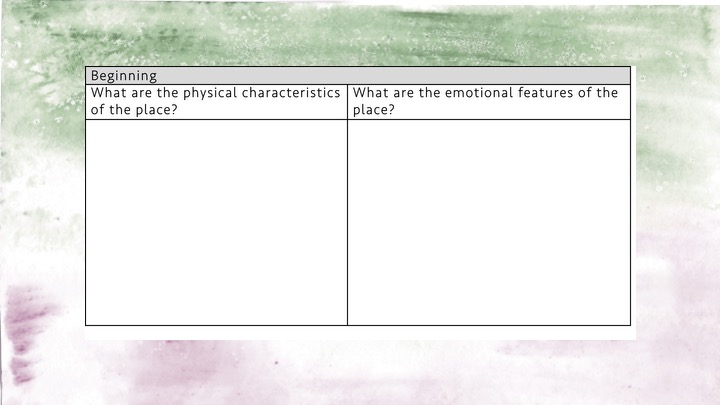
Are there symbolic elements in the setting?
Is there nature?
What kind of relationships does your character have in this setting?
Does the setting meet a need?
Does your character feel secure or threatened?
Try to get deep inside these feelings.
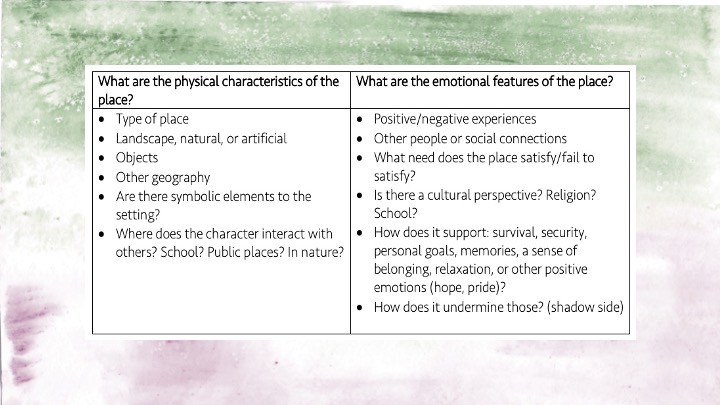
Okay – let’s take a moment to reflect on what you discovered about your beginning.
Perhaps you found a particular object that shows us your character’s emotional connection?
Maybe there’s something they’re going to lose?
You might ask yourself why did I pick this setting?
Does it work with or against my character’s emotional goal?
The purpose of this process is to uncover your character’s subconscious story about place. Try to feel what they’re missing in the first setting. Or what’s important to them.
This can be emotional work – and that’s the point. When you really feel your setting, when you can really understand how your character relates to their surroundings at an emotional level, you are adding depth and meaning to your writing.
All right – now let’s consider the end of your story.
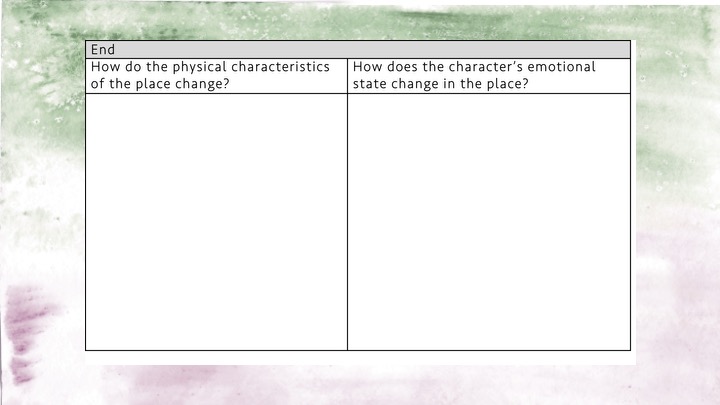
In box three, think about how your character’s physical setting changed over the course of your story. In the last box, explore how your character’s emotional setting changed.
Are they in the same place?
Has something been added or taken away?
Did your character alter their setting?
Does their new setting remind them of the old one? Or is it a complete opposite?
Does this new setting work with or against their emotional goal?
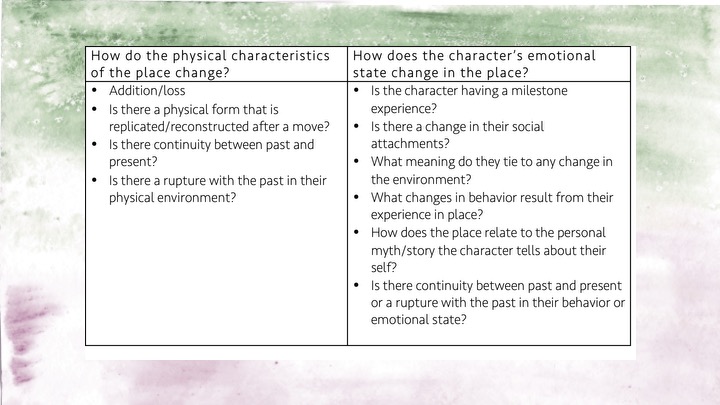
Consider the story your protagonist tells about themselves: Has the story changed like Jeff’s? From abandoned to home? Or something else?
How does the setting support their emotional change?
As you work on your story, you can keep coming back to these questions. You’ll notice something you put in your draft that, when you consider it again, can be that symbolic element that repeats through the story, like the ocean and freedom did for Dicey. Or like the island metaphor does for Jeff.
Keep asking yourself which details your characters notice because of their emotional background?
What change in setting will support their emotional change?
Don’t just go for the detail but go for the emotional truth.
Think about your own place attachments and try to imagine how your character would experience place with similarly intense feelings.
If you feel lost in your story, draw a map, notice the details, and ask yourself “why does this matter?”
You may be surprised at what you uncover.

As I was researching setting, I began to notice ways that place attachment has played out in my own life.
When I was nine, my family lived in a rental house in Minnesota for one year. This was one of the 23 houses I’ve lived in – so far.
My mom would drive us down to the Piggly Wiggly and there was a tall blue Victorian house right across the street from the parking lot. Every time we went to the store, I stared into that house, trying to imagine what it would be like to live there.
I longed to live in that house. I figured they probably had blue and white dishes to match the outside. A small white dog. Lots of books. And it would be peaceful and calm. Probably no curled up millipedes in the shower, like we had back in our rental house.
We only lived in that town for one year, but that house made a huge impression on me. It was everything I wanted.
I’ve thought about that blue house from time to time, just in passing. I wasn’t yearning for it, but it was there, in my background story. It was there when I nested in the blue velvet chairs in my grandparents’ study, working my way through their packed bookshelves. I’d have a feeling of familiarity when I saw certain rooms in magazines, or when I was in comfortable parts of other people’s homes.
Moving so many times had an impact on me. I crave stability. I long for a Home—a place that looks and feels on the outside the way I see myself on the inside. I surround myself with the objects that make me feel most authentic.
Right before I started this program, I decided I would need a place to read and study – this was something I’d longed for and always put on the bottom of my to-do list. My house was filled with other people and the spaces were devoted to their needs and I decided to make some changes.
I built some bookshelves into an odd nook and looked for a reading chair. I found two old chairs with their foam falling out and had them reupholstered. I also painted my house around the same time.
Here’s what my reading area looks like now. And the outside of the house is blue. Coincidence?
Probably not.
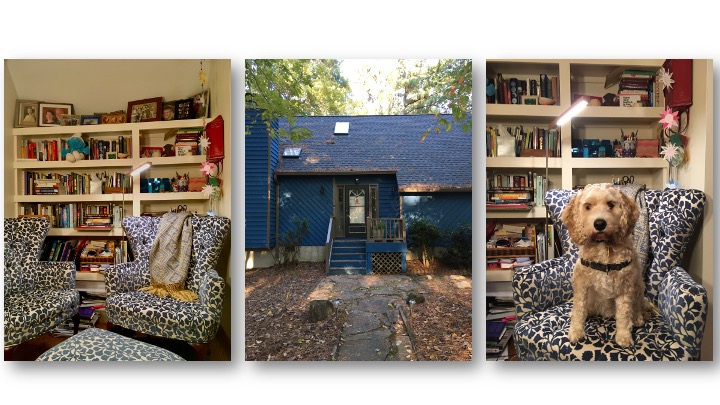
But I didn’t do any of this intentionally – I really didn’t connect the Piggly Wiggly house to my own house until I started down this research path.
My space has meaning: The bookshelves, the comfortable chair… It even has the dog! That’s when I realized I had altered my space to match my inner narrative of who I am.
The unused space became a place when I filled it with meaningful objects and connected it to the story of who I am.
My home is my sanctuary.
It makes my dreams real, for everyone to see.
My setting supports my emotional goal of being a writer.
Every day, I’m both adult me, and that nine-year-old bookworm, walking into the blue house by the Piggly Wiggly.
When we take the time to clarify our character’s emotional connection to their setting and to explore how their setting and their emotions change over the course of the story, we enrich our work.
As writers, we want everything in the story to carry emotional weight. Instead of choosing convenient or easy setting elements, I encourage you to dig deeper. Unearth your character’s subconscious story about place, understand how they are trying to meet their emotional needs through their surroundings. Think about how their setting is working with or against their emotional goal.
As long as I had an abandoned space in my house, and no place to read and write, I was denying an important part of who I am.
Committing to VCFA, building the new shelves – these acts have altered my story of who I am in the world.
I’m not just a planner writing a little bit on the side.
I am a writer.

Your readers have place bonds. Connect with them. Share this human experience with your readers, and they will feel the heart of your story beat twice. Once in your character’s chest, and once in their own.
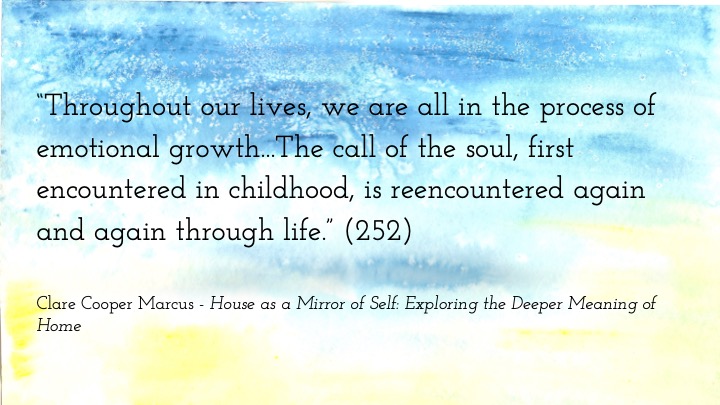
“Throughout our lives, we are all in the process of emotional growth—the call of the soul, first encountered in childhood, is reencountered again and again through life.”
I chose to end with this quote because ultimately we’re all here to connect soul-to-soul – with our readers. Understanding how you feel setting – like Cynthia Voigt and her geographic autobiographies – and understanding how your characters experience their settings –lifts your writing to another level.
So, next time you sit down to write. Remember College Hall. Remember that you have feelings about place and your characters do too. Remember that those feelings change and grow.
Explore your settings, turn your spaces into places.
Make them memorable.
This series is adapted from my critical thesis for an MFA at Vermont College of Fine Arts.
